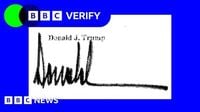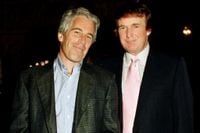President Donald Trump is once again at the center of controversy as new details emerge about his connections to the late financier Jeffrey Epstein, reigniting public scrutiny and political debate. On September 10, 2025, Trump forcefully denied authoring a provocative birthday letter to Epstein, which had surfaced as part of a trove of documents released by Democrats in the US House of Representatives. The note, allegedly penned for Epstein’s 50th birthday in 2003, features a sketched outline of a naked woman with a signature said to be Trump’s—placed in a suggestive spot on the image. Trump, speaking to reporters in Washington, DC, insisted, "It’s not my signature, and it’s not the way I speak. And anybody that has covered me for a long time knows that’s not my language. It’s nonsense.”
The White House, backing the president’s claims, announced its support for a forensic analysis of the signature to prove it was not Trump’s. “The president did not write this letter. He did not sign this letter,” stated White House press secretary Karoline Leavitt, as reported by Reuters. Despite these denials, the controversy has only deepened, with the so-called “birthday book”—a 238-page scrapbook commemorating Epstein’s milestone—now public. Alongside Trump’s alleged note, the book contains greetings from other high-profile figures such as former President Bill Clinton, Apollo Global Management cofounder Leon Black, and former Harvard law professor Alan Dershowitz, according to The Wall Street Journal.
The existence of the letter first came to light in July 2025, when The Wall Street Journal published a story detailing its contents. Trump was quick to respond, stating, “I never wrote a picture in my life” and “I don’t draw pictures.” However, as CNN pointed out, evidence suggests Trump did in fact draw pictures during the period in question. Later, Trump shifted his defense, speculating that “somebody could have written a letter and used my name.” But in a dramatic twist, Trump filed a lawsuit against the newspaper’s parent company, claiming the letter was a fabrication and did not exist at all—only for the letter to be found among Epstein’s estate records, undermining his legal argument.
The image of the letter, released by House Democrats on September 8, 2025, quickly went viral. The White House attempted to dismiss its authenticity, arguing that the signature was “so different from Trump’s that it was obviously not his.” Yet handwriting experts and journalists noted the signature closely matched Trump’s known signatures from the same era, raising more questions than answers. As CNN observed, “His denials haven’t added up.”
Trump’s relationship with Epstein has long been a source of speculation and rumor. In the 1990s and early 2000s, the two men moved in similar social circles, and Trump once described Epstein as a “terrific guy” who liked women “on the younger side.” Trump has always denied any prior knowledge of Epstein’s criminal activities, claiming the two had a falling out more than two decades ago after Epstein allegedly tried to recruit young women working at Trump’s Mar-a-Lago resort. As BBC and Al Jazeera have reported, Trump’s supporters—especially those in the Make America Great Again (MAGA) movement—have been divided, with some believing Trump would expose a vast conspiracy involving Epstein and other elite figures. The recent law enforcement review, which concluded Epstein died by suicide and found no evidence of a “client list” or blackmail operation, only fueled further outrage among conspiracy theorists.
But the birthday letter is only one part of a broader set of unresolved questions. The administration’s handling of related matters has drawn criticism from across the political spectrum, with both Trump’s detractors and some former allies expressing skepticism about the shifting narratives. For example, the unexplained transfer of Ghislaine Maxwell—Epstein’s longtime associate and convicted accomplice—to a minimum-security prison camp just 40 days before September 9, 2025, has raised eyebrows. Maxwell’s transfer came around the time she granted an interview to Deputy Attorney General Todd Blanche, leading some, including her attorney Arthur Aidala, to suggest there may have been a quid pro quo. Aidala told CNN, “Anybody who’s represented by a lawyer who knows what they’re doing, goes in and meets with the government, there’s always a quid pro quo.”
Despite the release of interview transcripts, the White House has yet to explain the rationale behind Maxwell’s transfer. Trump has publicly stated he is not considering clemency for Maxwell, but has, at times, left the door open to the possibility. The lack of transparency has fueled speculation about whether Maxwell received “a benefit” in exchange for her cooperation with authorities.
Another sensitive issue is Trump’s evolving statements regarding Virginia Giuffre, perhaps Epstein’s most recognized victim. Giuffre, who died by suicide earlier in 2025, was recruited from Mar-a-Lago by Maxwell, a fact Trump only fully acknowledged in late August 2025 after years of incomplete or evasive statements. When pressed in 2019 about his falling out with Epstein, Trump said, “The reason doesn’t make any difference, frankly.” Only recently did he confirm that Maxwell had recruited Giuffre from his property, stating, “I think she worked at the spa. I think so. I think that was one of the people. Yeah, he stole her.” Giuffre’s family has since questioned whether Trump was aware of Epstein and Maxwell’s criminal actions, a concern echoed by victims’ advocates.
The administration’s approach to the release of Epstein-related files has also been inconsistent. After initially promising full transparency, the Justice Department reversed course in early July 2025, citing concerns about protecting victims and innocent individuals named in the documents. This reversal came shortly after Trump was informed in May 2025 that his name appeared in the files. Around the same time, FBI Director Kash Patel and Deputy Director Dan Bongino appeared on Fox News to disavow conspiracy theories about Epstein’s death, asserting that Epstein had indeed died by suicide. Trump initially denied knowing his name was in the files, but later statements contradicted this, further muddying the waters.
All these developments have led to growing suspicion among Epstein’s victims, their allies, and the public that a cover-up may be underway. While Trump does not face any formal accusations of wrongdoing in relation to Epstein, his shifting explanations and the administration’s lack of clarity have only intensified speculation. As CNN put it, “To the extent they do, Trump and his team have themselves to blame.”
With the controversy showing no sign of abating, Trump’s past associations and the administration’s opaque handling of Epstein-related matters continue to cast a long shadow over the White House. The American public, left with more questions than answers, remains watchful as the story unfolds.





